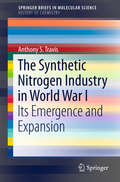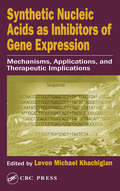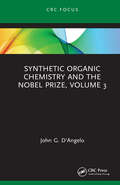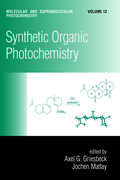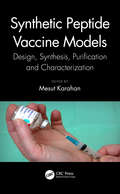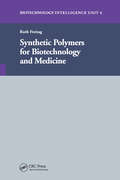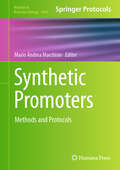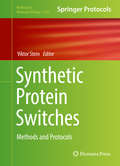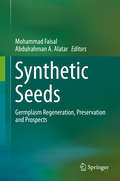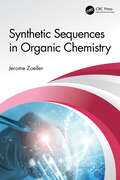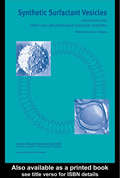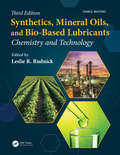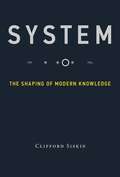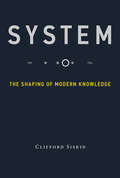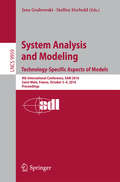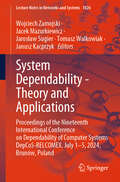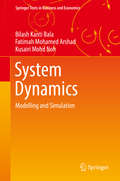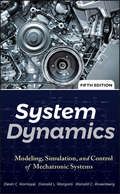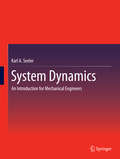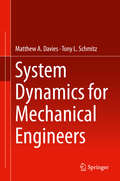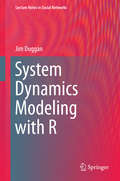- Table View
- List View
The Synthetic Nitrogen Industry in World War I
by Anthony S. TravisThis concise brief describes how the demands of World War I, often referred to as the Chemists' War, led to the rapid emergence of a new key industry based on fixation of atmospheric nitrogen. Then, as now, nitrogen products, including nitric acid, and nitrates, were essential for both fertilizers and in the manufacture of modern explosives. During the first decade of the twentieth century, this stimulated research into and application of novel processes. This book illustrates how from late 1914 the relations and developments in the first modern military-industrial complex enabled the great capital expenditures and technological advances that accelerated massive expansion, particularly of the BASF Haber-Bosch high-pressure process, that determined the direction of the post-war chemical industry.
Synthetic Nucleic Acids as Inhibitors of Gene Expression: Mechanisms, Applications, and Therapeutic Implications
by Levon Michael KhachigianIn the post-genomic era we have, at our fingertips, an incredible array of genomic sequences from a multitude of complex organisms. There remains, however, the critical need to understand the precise roles individual genes play in complex biological milieu. Bringing together authoritative reviews by renowned international leaders, this book presents cutting-edge research on inhibitors of gene expression and nucleic acid-based drugs. With numerous charts, diagrams, and graphs, the book covers the subject from lab bench to cancer-related clinical trials, making it an up-to-date and critical resource. Coverage includes discussions of ribozyme subtypes, structure-function aspects, and therapeutic applications; DNAzymes, their various subtypes, kinetics and biochemistry, and applications in target validation. Lastly, the mechanisms and multiple therapeutic applications of double-stranded oligonucleotide decoys are described.
Synthetic Organic Chemistry and the Nobel Prize Volume 1 (Synthetic Organic Chemistry and the Nobel Prize)
by John G. D'AngeloThe Nobel Prize is science’s highest award, as is the case with non-science fields too, and it is therefore arguably the most internationally recognized award in the world. This unique set of volumes focuses on summarizing the Nobel Prize within organic chemistry, as well as the specializations within this specialty. Any reader researching the history of the field of organic chemistry will be interested in this work. Furthermore, it serves as an outstanding resource for providing a better understanding of the circumstances that led to these amazing discoveries and what has happened as a result, in the years since. An outstanding resource which enables readers to better understand the conditions that led to these Nobel Prize amazing discoveries To an extent the roots of organic chemistry have been forgotten or lost and this set of volumes bridges the gap Unique set of volumes, no other book publication in the field competes and only press releases announcing the prizes from recent years exist "More than any other branch of chemistry, organic chemists look to history, so the readers will certainly enjoy this compilation " Appeals to a diverse audience including upcoming as well as modern practicing chemists, and provides the historical context of these discoveries
Synthetic Organic Chemistry and the Nobel Prize, Volume 2 (Synthetic Organic Chemistry and the Nobel Prize)
by John G. D'AngeloThe Nobel Prize is the highest award in science, as is the case with nonscience fields too, and it is, therefore, arguably the most internationally recognized award in the world. This unique set of volumes focuses on summarizing the Nobel Prize within organic chemistry, as well as the specializations within this specialty. Any reader researching the history of the field of organic chemistry will be interested in this work. Furthermore, it serves as an outstanding resource for providing a better understanding of the circumstances that led to these amazing discoveries and what has happened as a result, in the years since.
Synthetic Organic Chemistry and the Nobel Prize, Volume 3 (Synthetic Organic Chemistry and the Nobel Prize)
by John G. D'AngeloThe Nobel Prize is the highest award in science, as is the case with nonscience fields too, and it is, therefore, arguably the most internationally recognized award in the world. This unique set of volumes focuses on summarizing the Nobel Prize within organic chemistry, as well as the specializations within this specialty. Any reader researching the history of the field of organic chemistry will be interested in this work. Furthermore, it serves as an outstanding resource for providing a better understanding of the circumstances that led to these amazing discoveries and what has happened as a result, in the years since.
Synthetic Organic Photochemistry
by Axel G. Griesbeck Jochen MattayWith contributions from 24 international authorities, Synthetic Organic Photochemistry offers a leading-edge presentation of the most recent and in-demand applications of photochemical methodologies. Outlining a wide assortment of reaction types entailing cycloadditions, cyclizations, isomerizations, rearrangements, and other organic syntheses, thi
Synthetic Peptide Vaccine Models: Design, Synthesis, Purification and Characterization
by Mesut KarahanA new generation of technological vaccines protect against many infectious diseases. This book describes synthetic peptide-based vaccine prototypes – the future of vaccination. Production of peptides becomes simple using automatic synthesizers. Peptides are weak immunogen and need adjuvants to provide an effective autoimmune response, which is why peptide antigens are conjugated with biopolymers and loaded with nanoparticles. The book illustrates the use of peptides vaccine systems and makes predictions of future development not only for infectious diseases, but also for cancers and brain diseases such as Alzheimer, Parkinson and psychiatric diseases. Key Features Summarizes current studies on technological vaccines Describes the uses of vaccines for the prevention of brain diseases Reviews the ways different polymers are used to enhance vaccine efficacy
Synthetic Polymers for Biotechnology and Medicine
by Ruth FreitagThis book covers topics including the delivery of biologicals using synthetic polymers, cell encapsulation, and gene delivery. It deals with the use of synthetic polymers for the purpose of isolating biologicals by describing the use of stimulus-responsive polymers.
Synthetic Promoters: Methods and Protocols (Methods in Molecular Biology #2844)
by Mario Andrea MarchisioThis detailed volume presents numerous methods used in bioengineering to create new synthetic promoters in various organisms. Additionally, the book explores mathematical models, novel screening and construction techniques, modulation of protein expression, and various applications ranging from biosensors to viral resistance. Written for the highly successful Methods in Molecular Biology series, chapters include introductions to their respective topics, lists of the necessary materials and reagents, step-by-step and readily reproducible laboratory protocols, and tips on troubleshooting and avoiding known pitfalls. Authoritative and practical, Synthetic Promoters: Methods and Protocols offers researchers a guide to the latest advances in this branch of synthetic biology.
Synthetic Protein Switches
by Viktor SteinThis detailed book provides state-of-the-art protocols to facilitate the construction of synthetic protein switches for a variety of applications in biotechnology and basic research. Beginning with general strategies, the volume continues with coverage of peptide switches, fluorescent and bioluminescent sensors, β-lactamase sensors, proteolytic sensors, optogenetic switches, as well as cellular signaling switches. Written for the highly successful Methods in Molecular Biology series, chapters include introductions to their respective topics, lists of the necessary materials and reagents, step-by-step, readily reproducible laboratory protocols, and tips on troubleshooting and avoiding known pitfalls. Authoritative and practical, Synthetic Protein Switches: Methods and Protocols serves as a useful reference for life scientists from diverse research fields that range from traditional, discovery-centered disciplines, like cancer research, to newly emerging disciplines, such as synthetic biology.
Synthetic Seeds: Germplasm Regeneration, Preservation and Prospects
by Mohammad Faisal Abdulrahman A. AlatarThis book introduces the reader to synthetic or artificial seeds, which refer to alginate encapsulated somatic embryos, vegetative buds or any other micropropagules that can be used as seeds and converted into plantlets after propagating under in vitro or in vivo conditions. Moreover, synthetic seeds retain their potential for regeneration even after low-temperature storage. The production of synthetic or artificial seeds using micropropagules opens up new vistas in agricultural biotechnology. Encapsulated propagules could be used for in vitro regeneration and mass multiplication at reasonable cost. In addition, these propagules may be used for germplasm preservation of elite plant species and the exchange of plant materials between national and international laboratories. This book offers state-of-the-art findings on methods, applications and prospects of synthetic or artificial seeds.
Synthetic Sequences in Organic Chemistry
by Jerome ZoellerDrawing on the vast amount of experience the author has gained from working in industrial and university laboratories, this collection of excerpt reports contains essential details from literature relevant to the synthesis of compounds on a milligram to kilogram scale. The excerpts are composed using ChemDraw software and compiled in a Word document. A number of the compounds that have eluded efficient preparation in the past are now presented. Material which will improve any chemist's existing synthetic methodology can be found here. Each of the six chapters, with eighty excerpts, illustrates a novel application of syntheses selected from twenty-first-century literature. Features: This professional text describes many of the classical and contemporary methods of synthesis that have recently found great value in the preparation of needed target compounds in the required quantities. Each example is extracted from a specific literature publication, which the user then would examine for details. This user-friendly professional text provides enormous aid in designing synthetic sequences. Appeals to a broad audience in both academic and industrial laboratories, basically any chemist in need of designing a synthetic sequence or just selecting a single reaction. Author has a vast amount of experience gained from working in academic and industrial laboratories.
Synthetic Sorbent Materials Based on Metal Sulphides and Oxides
by D.S. Sofronov K.N. Belikov M. Rucki S.N. Lavrynenko Z. Siemiątkowski E. Yu. Bryleva O.M. OdnovolovaSynthetic Sorbent Materials Based on Metal Sulphides and Oxides focuses on development of inorganic nanomaterials for removal of metallic species from the aqueous environment. General synthetic methods to prepare such materials are lacking. This book investigates problems of controlled synthesis of these materials and the effect of their morphological characteristics on their sorption capacity. • Synthesizes experimental data on the synthesis of micro- and nanoparticles of zinc, copper, and cadmium sulfides, iron oxides, and manganese oxyhydroxide. • Discusses controlled synthesis of zinc, cadmium, and copper sulfide particles and their sorption properties. • Describes production of iron oxides (hematite and magnetite) and manganese oxyhydroxide particles. • Features numerous SEM images of the obtained nanostructures and original graphs of various characteristics. • Offers practical recommendations. This book is of interest to researchers and scientists working with inorganic synthesis and properties of sorption materials.
Synthetic Surfactant Vesicles: Niosomes and Other Non-Phospholipid Vesicular Systems
by L F UchegbuThe self-assembly of synthetic surfactants and other non-phospholipids into vesicles was first studied in the 1970s by cosmetic scientists when non-ionic surfactant vesicles or niosomes were reported. Since this time a large body of research has sought to define these systems primarily as drug carriers and also as features of interest to the colloid scientist. Synthetic surfactant vesicles, as the name implies, may also be fabricated from a vast array of amphiphiles, including a number of pharmaceutically acceptable materials. They may also be prepared in a variety of shapes and sizes and have a number of applications. This book is designed to serve as an introductory text to the science of non-phospholipid vesicles and will be of use to colloid, drug delivery, cosmetic, and materials scientists. It aims to acquaint the reader with the physicochemistry and biomedical applications of these synthetic surfactant non-phospholipid vesicles. Part one introduces the reader to physicochemical aspects of these synthetic surfactant dispersions and explores the diversity of materials that may be used to formulate vesicles. Part two details methods of vesicle preparation and the application of synthetic surfactant vesicles in a variety of fields ranging from anti-cancer chemotherapy to immunization.
Synthetics, Mineral Oils, and Bio-Based Lubricants: Chemistry and Technology (Chemical Industries)
by Leslie R. RudnickHighlighting the major economic and industrial changes in the lubrication industry since the first edition, Synthetics, Mineral Oils, and Bio-Based Lubricants: Chemistry and Technology, Third Edition highlights the major economic and industrial changes in the lubrication industry and outlines the state of the art in each major lubricant application area. Chapters cover the use of lubricant fluids, growth or decline of market areas and applications, potential new applications, production capacities, and regulatory issues, including biodegradability, toxicity, and food production equipment lubrication. The highly-anticipated third edition features new and updated chapters including those on automatic and continuously variable transmission fluids, fluids for food-grade applications, oil-soluble polyalkylene glycols, functional bio-based lubricant base stocks, farnesene-derived polyolefins, estolides, bio-based lubricants from soybean oil, and trends in construction equipment lubrication. Features include: Contains an index of terms, acronyms, and analytical testing methods. Presents the latest conventions for describing upgraded mineral oil base fluids. Considers all the major lubrication areas: engine oils, industrial lubricants, food-grade applications, greases, and space-age applications Includes individual chapters on lubricant applications—such as environmentally friendly, disk drive, and magnetizable fluids—for major market areas around the globe. In a single, unique volume, Synthetics, Mineral Oils, and Bio-Based Lubricants: Chemistry and Technology, Third Edition offers property and performance information of fluids, theoretical and practical background to their current applications, and strong indicators for global market trends that will influence the industry for years to come.
Syria as an Arena of Strategic Competition
by Jeffrey Martini Erin York William YoungLess than two years since the beginning of the uprising in Syria, localized protests have morphed into full-blown civil conflict, and external actors have become involved as well. RAND conducted an analytic exercise to generate a greater understanding of the parties and issues in play, including the actors, their motivations, and potential impact of their activities.
System: The Shaping of Modern Knowledge
by Clifford SiskinA system can describe what we see (the solar system), operate a computer (Windows 10), or be made on a page (the fourteen engineered lines of a sonnet). In this book, Clifford Siskin shows that system is best understood as a genre -- a form that works physically in the world to mediate our efforts to understand it. Indeed, many Enlightenment authors published works they called "system" to compete with the essay and the treatise. Drawing on the history of system from Galileo's "message from the stars" and Newton's "system of the world" to today's "computational universe," Siskin illuminates the role that the genre of system has played in the shaping and reshaping of modern knowledge. Previous engagements with systems have involved making them, using them, or imagining better ones. Siskin offers an innovative perspective by investigating system itself. He considers the past and present, moving from the "system of the world" to "a world full of systems." He traces the turn to system in the seventeenth and eighteenth centuries, and describes this primary form of Enlightenment as a mediator of political, cultural, and social modernity -- pointing to the moment when people began to "blame the system" for working both too well ("you can't beat the system") and not well enough (it always seems to "break down"). Throughout, his touchstones are: what system is and how it has changed; how it has mediated knowledge; and how it has worked in the world.
System: The Shaping of Modern Knowledge (Infrastructures)
by Clifford SiskinThe role that “system” has played in the shaping and reshaping of modern knowledge, from Galileo and Newton to our own “computational universe.”A system can describe what we see (the solar system), operate a computer (Windows 10), or be made on a page (the fourteen engineered lines of a sonnet). In this book, Clifford Siskin shows that system is best understood as a genre—a form that works physically in the world to mediate our efforts to understand it. Indeed, many Enlightenment authors published works they called “system” to compete with the essay and the treatise. Drawing on the history of system from Galileo's “message from the stars” and Newton's “system of the world” to today's “computational universe,” Siskin illuminates the role that the genre of system has played in the shaping and reshaping of modern knowledge.Previous engagements with systems have involved making them, using them, or imagining better ones. Siskin offers an innovative perspective by investigating system itself. He considers the past and present, moving from the “system of the world” to “a world full of systems.” He traces the turn to system in the seventeenth and eighteenth centuries, and describes this primary form of Enlightenment as a mediator of political, cultural, and social modernity—pointing to the moment when people began to “blame the system” for working both too well (“you can't beat the system”) and not well enough (it always seems to “break down”). Throughout, his touchstones are: what system is and how it has changed; how it has mediated knowledge; and how it has worked in the world.
System Analysis and Modeling. Technology-Specific Aspects of Models
by Jens Grabowski Steffen HerboldThis book constitutes revised papers of the proceedings of the 9th International Workshop on System Analysis and Modeling, SAM 2016, held in Saint-Melo, France, in October 2016. The 15 full papers presented were carefully reviewed and selected from 31 submissions. The contributions are organized in topical theme named: Technology-Specific Aspects of Models. The volume reflects the five sessions of the conference. The first two sessions are closely aligned with the conference theme with a session on the Internet of Things and a session on Technology-specific Aspects. The other three sessions cover aspects regarding modeling languages and model-driven development in general and were organized in the sessions Languages, Configurations and Features, and Patterns and Compilation.
System Dependability - Theory and Applications: Proceedings of the Nineteenth International Conference on Dependability of Computer Systems DepCoS-RELCOMEX. July 1–5, 2024, Brunów, Poland (Lecture Notes in Networks and Systems #1026)
by Janusz Kacprzyk Wojciech Zamojski Jacek Mazurkiewicz Jarosław Sugier Tomasz WalkowiakThis book presents a selection of papers about problems which arise in dependability studies of contemporary computer systems and networks. Their collection should be an interesting and inspiring source material for scientists, researchers, engineers, and students who must consider diverse dependability characteristics in design, analysis, or maintenance of computer systems and networks. The papers were presented during the 19th DepCoS-RELCOMEX conference which was the next event in a series organized annually since 2006. Originating as a scientific platform for discussions of reliability aspects in computer engineering, the topical scope of the conference has been constantly expanded to incorporate new dependability challenges brought by recent advances in systems and information technologies. Currently, dependable operation in the context of computer processing means obtaining reliable (true and timely) results in the conditions of processing both quantitative and qualitative data, using precise or fuzzy (often: imitating) models and algorithms. With increasing use of artificial intelligence algorithms and tools, dependability in contemporary information technology and computer engineering calls for methods based on cognitive systems and deep learning techniques. Topical variety of the papers included in these proceedings proves that almost all applications of modern computer systems and networks must take into account the aspect of dependability and also illustrates a wide diversity of multidisciplinary subjects which needs to be considered in this context.
System Dynamics
by Bilash Kanti Bala Fatimah Mohamed Arshad Kusairi Mohd NohThis book covers the broad spectrum of system dynamics methodologies for the modelling and simulation of complex systems: systems thinking, causal diagrams, systems structure of stock and flow diagrams, parameter estimation and tests for confidence building in system dynamics models. It includes a comprehensive review of model validation and policy design and provides a practical presentation of system dynamics modelling. It also offers numerous worked-out examples and case studies in diverse fields using STELLA and VENSIM. The system dynamics methodologies presented here can be applied to nearly all areas of research and planning, and the simulations provided make the complicated issues more easily understandable. System Dynamics: Modelling and Simulation is an essential system dynamics and systems engineering textbook for undergraduate and graduate courses. It also offers an excellent reference guide for managers in industry and policy planners who wish to use modelling and simulation to manage complex systems more effectively, as well as researchers in the fields of modelling and simulation-based systems thinking.
System Dynamics
by Donald L. Margolis Ronald C. Rosenberg Dean C. KarnoppAn expanded new edition of the bestselling system dynamics book using the bond graph approachA major revision of the go-to resource for engineers facing the increasingly complex job of dynamic systems design, System Dynamics, Fifth Edition adds a completely new section on the control of mechatronic systems, while revising and clarifying material on modeling and computer simulation for a wide variety of physical systems.This new edition continues to offer comprehensive, up-to-date coverage of bond graphs, using these important design tools to help readers better understand the various components of dynamic systems. Covering all topics from the ground up, the book provides step-by-step guidance on how to leverage the power of bond graphs to model the flow of information and energy in all types of engineering systems. It begins with simple bond graph models of mechanical, electrical, and hydraulic systems, then goes on to explain in detail how to model more complex systems using computer simulations. Readers will find:New material and practical advice on the design of control systems using mathematical modelsNew chapters on methods that go beyond predicting system behavior, including automatic control, observers, parameter studies for system design, and concept testingCoverage of electromechanical transducers and mechanical systems in plane motionFormulas for computing hydraulic compliances and modeling acoustic systemsA discussion of state-of-the-art simulation tools such as MATLAB and bond graph softwareComplete with numerous figures and examples, System Dynamics, Fifth Edition is a must-have resource for anyone designing systems and components in the automotive, aerospace, and defense industries. It is also an excellent hands-on guide on the latest bond graph methods for readers unfamiliar with physical system modeling.
System Dynamics
by Karl A. SeelerThis unique textbook takes the student from the initial steps in modeling a dynamic system through development of the mathematical models needed for feedback control. The generously-illustrated, student-friendly text focuses on fundamental theoretical development rather than the application of commercial software. Practical details of machine design are included to motivate the non-mathematically inclined student.
System Dynamics for Mechanical Engineers
by Matthew A. Davies Tony L. SchmitzThis textbook is ideal for mechanical engineering students preparing to enter the workforce during a time of rapidly accelerating technology, where they will be challenged to join interdisciplinary teams. It explains system dynamics using analogies familiar to the mechanical engineer while introducing new content in an intuitive fashion. The fundamentals provided in this book prepare the mechanical engineer to adapt to continuous technological advances with topics outside traditional mechanical engineering curricula by preparing them to apply basic principles and established approaches to new problems. This book also: · Reinforces the connection between the subject matter and engineering reality · Includes an instructor pack with the online publication that describes in-class experiments with minimal preparation requirements · Provides content dedicated to the modeling of modern interdisciplinary technological subjects, including opto-mechanical systems, high-speed manufacturing equipment, and measurement systems · Incorporates MATLAB® programming examples throughout the text · Incorporates MATLAB® examples that animate the dynamics of systems
System Dynamics Modeling with R
by Jim DugganThis new interdisciplinary work presents system dynamics as a powerful approach to enable analysts build simulation models of social systems, with a view toward enhancing decision making. Grounded in the feedback perspective of complex systems, the book provides a practical introduction to system dynamics, and covers key concepts such as stocks, flows, and feedback. Societal challenges such as predicting the impact of an emerging infectious disease, estimating population growth, and assessing the capacity of health services to cope with demographic change can all benefit from the application of computer simulation. This text explains important building blocks of the system dynamics approach, including material delays, stock management heuristics, and how to model effects between different systemic elements. Models from epidemiology, health systems, and economics are presented to illuminate important ideas, and the R programming language is used to provide an open-source and interoperable way to build system dynamics models. System Dynamics Modeling with R also describes hands-on techniques that can enhance client confidence in system dynamic models, including model testing, model analysis, and calibration. Developed from the author's course in system dynamics, this book is written for undergraduate and postgraduate students of management, operations research, computer science, and applied mathematics. Its focus is on the fundamental building blocks of system dynamics models, and its choice of R as a modeling language make it an ideal reference text for those wishing to integrate system dynamics modeling with related data analytic methods and techniques.
